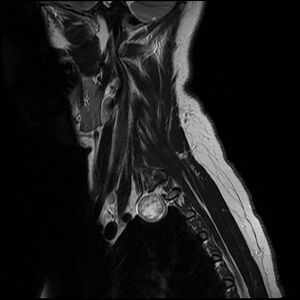Schwannoma
Schwannomas represent a relatively homogeneous group of tumors, they are mostly benign , well-differentiated tumors of the peripheral nervous system . Both peripheral nerves and spinal roots can be affected - with approximately 45% of schwannomas occurring in the head and neck area . Rare malignant forms with a tendency to metastasis are also known (less than 1% of all schwannomas).
These neoplasias grow out of Schwann cells , and are not characterized as having expansive behavior. Some schwannomas may be associated with type 2 neurofibromatosis (NF-2) in some patients . Typically, these are sporadic lesions; in the presence of NF-2, multiple findings can be diagnosed .
Diagnostics[edit | edit source]
- CT - is not as sensitive as MR, but it is often the first imaging method performed, according to which it is most often subsequently indicated for MR;
- MR - definitely clearer in comparison with CT, necessary examination to unambiguously confirm the incidence of the tumor.
Schwannomas appear to be well-defined neoplasias, with a relatively common cystic component, or hemorrhage. Calcification is absolutely exceptional.
Intracranial schwannomas[edit | edit source]
See the Vestibular Schwannom page for more information .
The most typical and most common schwannoma is the vestibular schwannoma , which grows from the area of the bridge-horn from the vestibulocochlear nerve (its vestibular part). The second most common place of incidence is the trigeminal nerve.
Occurrences of schwannomas in other cranial nerves (except the olfactory nerve and optic nerve , which lack Schwann's cells) are described, such as those growing from the facial nerve - most often in the facial nerve . In the case of expansion of facial schwannomas into the area of the angulus cerebellopontinus , they are easily mistaken for vestibular schwannomas . However, the incidence of these neoplasias is very low to rare in comparison with the above-mentioned schwannomas.
Spinal schwannomas[edit | edit source]
See Spinal Tumors for more information .
Spinal schwannomas grow from spinal roots, primarily intradurally extramedullary. However, in some patients, intramedullary schwannomas are also diagnosed (very rarely), or even purely extradural - depending on the location and expansion of the epicenter of the lesion growth.
Other locations[edit | edit source]
Other occurrences of schwannomas outside the intracranial localization and spinal roots include:
- intercostal nerves ,
- gastrointestinal nerves,
- retroperitoneal nerves ,
- posterior mediastinal nerves ,
- ulnar nerve ,
- peroneal nerve.
Treatment and prognosis[edit | edit source]
The specifics of the treatment and the prognosis itself are variable, it primarily depends on the location of the tumor - you will find them in specific articles that focus in more detail on individual tumors:
- vestibular schwannomas ,
- spinal schwannomas .
Schwannomas are most often resected surgically, the legitimate procedure is observation if the tumor does not behave expansively and the patient does not cause major problems in the form of neurological deficits, etc. Another treatment alternative is radiosurgery. Recurrence is very rare during radical resection.
Links[edit | edit source]
Related Articles[edit | edit source]
References[edit | edit source]
- WEISSLEDER, Ralph, Jack WITTENBERG and Mukesh HARISINGHANI. Primer of Diagnostic Imaging. - edition. Elsevier Mosby, 2011. 792 pp. ISBN 9780323065382 .
- BRANT, William and Clyde HELMS. Fundamentals of Diagnostic Radiology. - edition. Lippincott Williams & Wilkins, 2007. 1559 pp. ISBN 9780781761352 .
References[edit | edit source]
- ↑ BISWAS, Deb, Conor N. MARNANE and Ranjit MAL. Extracranial head and neck schwannomas — A 10-year review. Auris Nasus Larynx. 2007, vol. 3, vol. 34, pp. 353-359, ISSN 0385-8146. DOI: 10.1016 / j.anl.2007.01.006 .
- ↑ WANG, Jun, Mingming YU and Haobo ZHU. Retroperitoneal malignant schwannoma in a child. Journal of International Medical Research. 2018, year. 10, vol 46, pp. 4315-4322, ISSN 0300-0605. DOI: 10.1177 / 0300060518787644 .
- ↑ SINGH, Ran Vijai P., Sonia SUYS and Donald A. CAMPBELL. Malignant schwannoma of the cerebellum: Case report. Surgical Neurology. 1993, vol. 2, vol 39, pp. 128-132, ISSN 0090-3019. DOI: 10.1016 / 0090-3019 (93) 90090-n .
- ↑ HANEMANN, CO and DG EVANS. News on the genetics, epidemiology, medical care and translational research of Schwannomas. Journal of Neurology. 2006, vol. 12, vol 253, pp. 1533-1541, ISSN 0340-5354. DOI: 10.1007 / s00415-006-0347-0 .
- ↑ WEISSLEDER, Ralph, Jack WITTENBERG and Mukesh HARISINGHANI. Primer of Diagnostic Imaging. - edition. Elsevier Mosby, 2011. 792 pp. ISBN 9780323065382 .
- ↑ BRANT, William and Clyde HELMS. Fundamentals of Diagnostic Radiology. - edition. Lippincott Williams & Wilkins, 2007. 1559 pp. ISBN 9780781761352 .
- ↑ KONOVALOV, AN, A. SPALLONE and DJ MUKHAMEDJANOV. Trigeminal neurinomas a series of 111 surgical cases from a single institution. Acta Neurosirurgica. 1996, vol. 9, vol 138, pp. 1027-1035, ISSN 0001-6268. DOI: 10.1007 / bf01412304 .
- ↑ XU, Feng, Sida PAN and Fernando ALONSO. Intracranial Facial Nerve Schwannomas: Current Management and Review of Literature. World Neurosurgery. 2017, year. ?, vol. 100, pp. 444-449, ISSN 1878-8750. DOI: 10.1016 / j.wneu.2016.09.082 .
- ↑ MINOVI, Amir, Regina VOSSCHULTE and Erich HOFMANN. Facial Nerve Neuroma: Surgical Concept and Functional Results. Skull Base. 2004, vol. 04, vol. 14, pp. 195-200, ISSN 1531-5010. DOI: 10.1055 / s-2004-860948 .
- ↑ HALLIDAY, Jane, Scott A. RUTHERFORD and Martin G. MCCABE. An update on the diagnosis and treatment of vestibular schwannoma. Expert Review of Neurotherapeutics. 2017, year. 1, vol. 18, pp. 29-39, ISSN 1473-7175. DOI: 10.1080 / 14737175.2018.1399795 .
- ↑ PEKER, Selcuk. Non-Vestibular Schwannoma Radiosurgery. Progress in Neurological Surgery. 2019, year. ?, vol.?, pp. 159-165, ISSN 0079-6492. DOI: 10.1159 / 000493060 .


